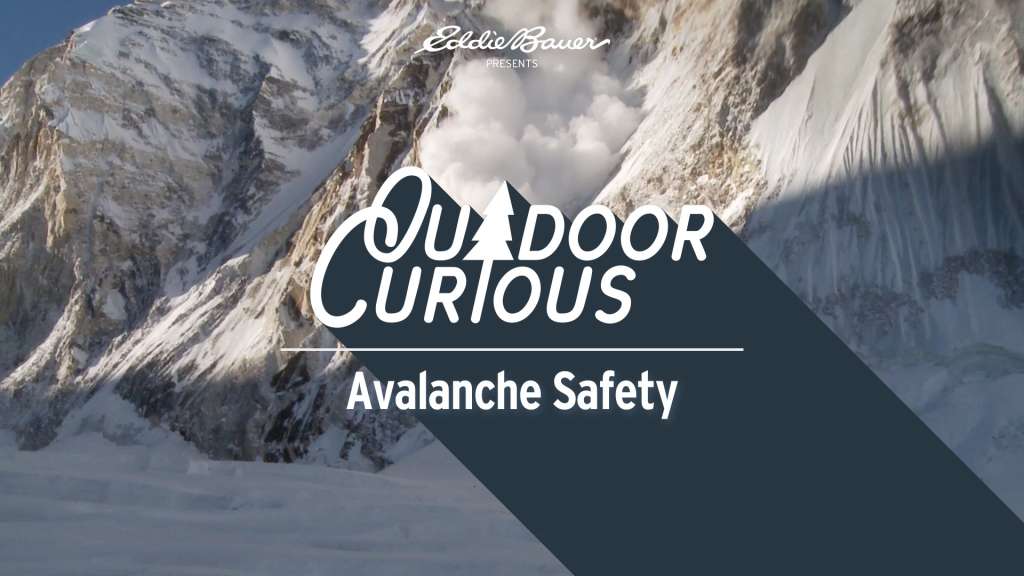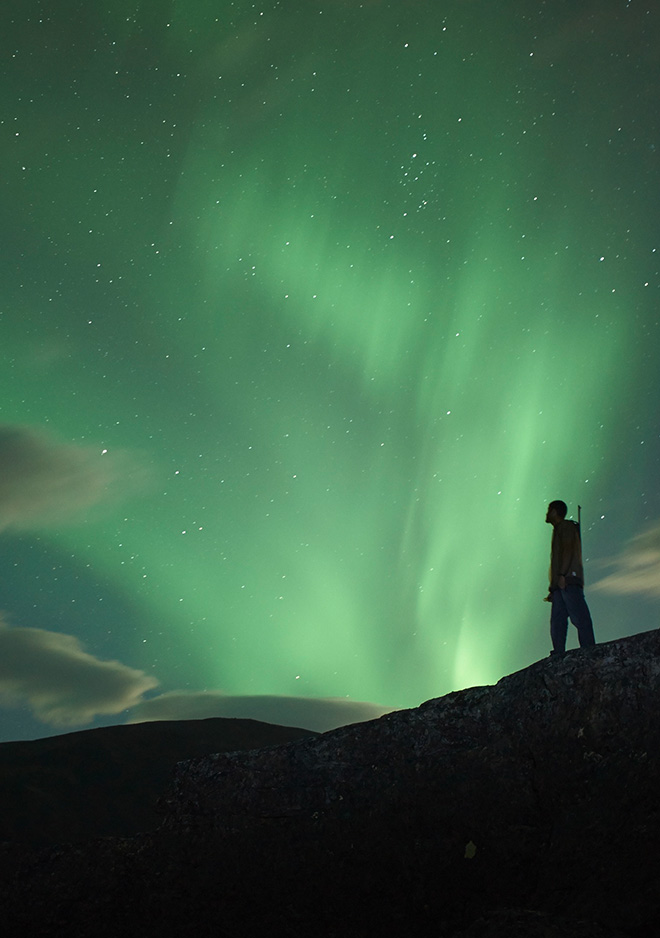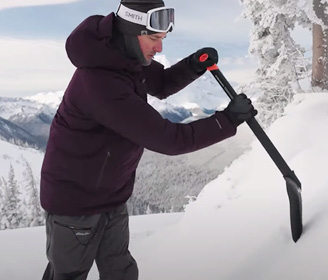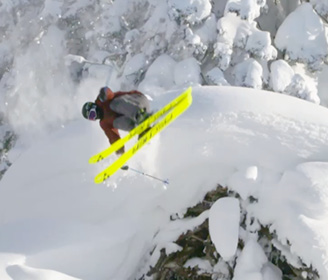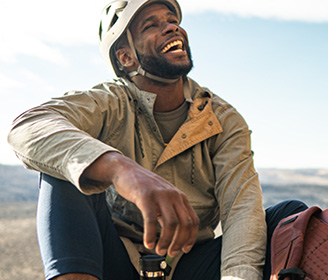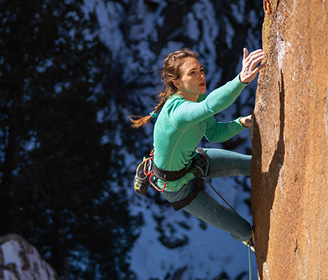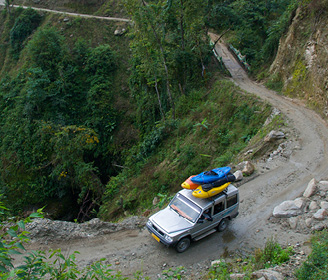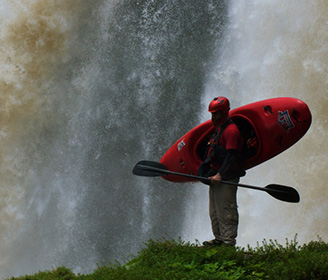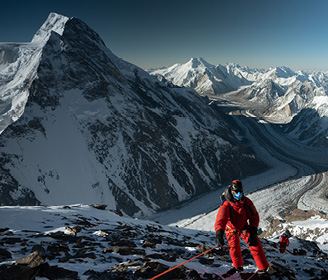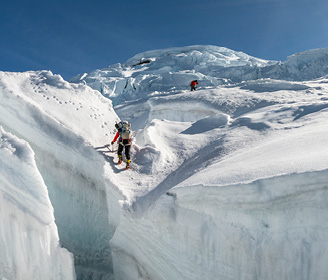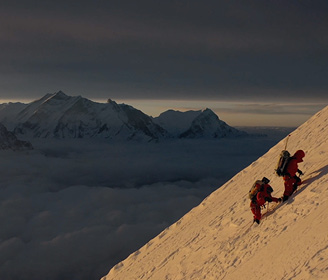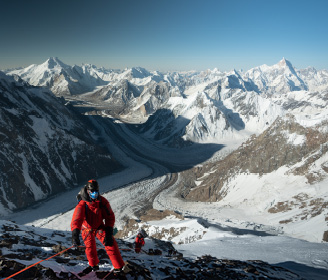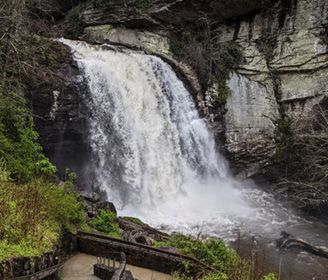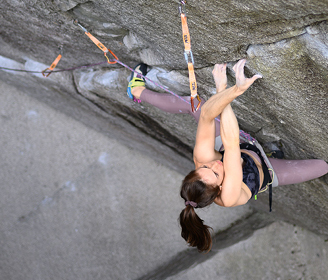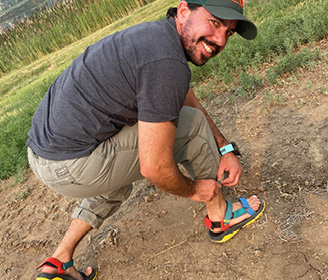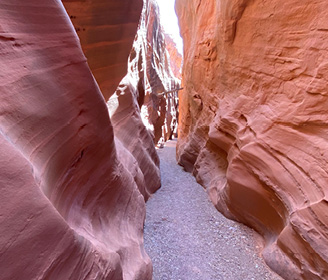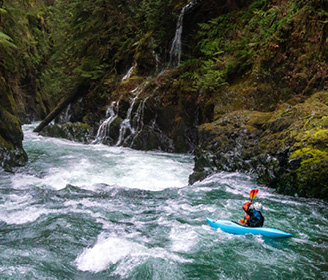Ever wonder what causes an avalanche? Eddie Bauer alpine climbing guide Angela Hawse has spent the last nine winters as an avalanche forecaster for Telluride Helitrax, and she’s here to answer the internet’s most asked questions about avalanche training and safety, avalanche gear, and much more.
00:25 – What is an avalanche, and what causes them?
An avalanche is a mass of snow that typically moves down a mountain slope at a high speed, entraining other snow, sometimes trees, rocks, mud, other debris, with it at an alarming rate. Any type of trigger can cause an avalanche when the load exceeds the capacity of the strength, so could be a person, could be wildlife, could be rockfall, or wind loading on a slope from snow being entrained in the wind coming from the opposite side. So there’s a number of different ways that avalanches can start.
01:07 -Why is avalanche safety so important?
Anytime that we are in the mountains when they’re covered with snow, avalanches are a hazard, and so it’s incredibly important that, one, that we carry the right equipment so we could conduct a companion rescue if our friends or another party got into an avalanche, and two, so we could be found.
01:31 – Are there different types of avalanches?
There sure are. There are a number of different types of avalanches, such as slab avalanches, wind slab avalanches, hard slab avalanches, soft slab avalanches, storm snow avalanches, loose snow avalanches, wet snow avalanches, glide avalanches. I’m probably missing one or two, so yeah, lots of different types of snow avalanches.
02:04 – Where do avalanches typically occur?
Avalanches typically occur on slopes that are above 28 to 30 degrees. Locations where avalanches occur are generally stripped bare of trees and vegetation. In the spring, the avalanches that can occur on much lower-angled slopes are also very time dependent, so in the morning, when it’s nice and and cold, and the snow pack’s frozen, you have a lot of stability, and then as the temperatures start to warm throughout the day, the water starts to percolate down through the snow pack, saturating the snow pack with water, which leads to avalanches when you have a less consolidated snow pack, and so spring avalanches are much more predictable than a winter avalanche, but both are easily avoidable.
02:54 – What are tips on reading terrain?
So slope angles are absolutely critical to know when you’re exploring an avalanche terrain, because once you get above the 28 degree level in a winter snow pack, an avalanche could occur. There’s some apps out there that you can use to look at the slope angle, based on angling your phone. It’ll act like an inclinometer and give you the actual degrees. Avalanches can also occur in tree-covered areas. It’s less common. Bad destruction often happens on the uphill side of the trees, so what’ll happen is you’ll see this flagging effect, where there’s no branches on the upside of the tree, but the downside of the tree has healthy branches, and that’s called flagging, and that’s a clear sign of avalanche paths.
03:45 – What gear is useful for avalanche safety?
There’s three components of avalanche safety gear that you need to have if you’re out in the backcountry. One’s an avalanche transceiver. An avalanche transceiver is a tool that emits a signal that is retrievable in the event of an avalanche. If you are buried in an avalanche, that is gonna help your partners locate you very quickly if they’ve practiced with their transceiver. The other tool that’s critical is an avalanche probe. An avalanche probe helps you pinpoint the exact location once you’ve located a signal in a buried person when their avalanche transceiver has been found. So then you deploy your avalanche shovel, which is your third essential piece of avalanche equipment, to start digging for that buried victim. There’s other things that are useful. Certainly, avalanche airbags are useful. A cell phone’s pretty critical in the event of an emergency. It’s not a bad idea to have a personal locator beacon, which is something like a spot device, or a Garmin, DeLorme, a basic first aid kit, basic repair kit, and then an emergency blanket. Just a little, lightweight, little emergency blanket you can get at any sporting goods store is a nice thing to have in the bottom of your pack, because in the event that someone is buried in an avalanche, they’re likely to be hypothermic.
05:17 – Can you trigger an avalanche?
You sure can. Like we said before, avalanches could be triggered by a number of ways. Certainly, human-triggered avalanches are probably one of the most common. There’s a number of ways that people can trigger an avalanche. Typically, it’s by skiing over a roll. That’s where people run into a little bit of an issue judging slope angle is when you start out with a roll, and that’s a very common place to trigger an avalanche is the start of that. Avalanches can also be triggered intentionally by highway forecasters, state patrol, to help mitigate the risk.
06:04 – What are the first steps when you feel like you’re gonna get caught in an avalanche?
Critical. Think quickly. Do what you can to gain speed, so you can actually gain some momentum so you can ski off to the side. And so it’s important before you even enter avalanche terrain that you have an exit strategy. Think on your feet, try to jettison your ski poles. If you’re caught in the avalanche, what you wanna do is try to swim. You wanna try to swim upstream, you wanna just keep moving, because if you lay limp, you’re most likely to end up in the bottom of the snow slope. If you’re in tree terrain, grab a tree. That’s probably one of your best things to do if you’re caught in an avalanche and there’s trees around you. It could be really difficult to discern what’s up and what’s down. Once the avalanche stops, if your head’s not above the snow, the way that you wanna react is, first, you want to get your hands as close as you can as your mouth and create an air pocket, because what’s gonna happen is, your breath is gonna encase an ice layer around your face, which is gonna make it difficult to breathe. Most people die from avalanches through asphyxiation, so you wanna make that air pocket around around your face with your hands, or put your elbow up, and just try to create that, and with the other hand, push it up where you think is in the up direction, because if you’re close to the surface, your hand might just get through, and then your partners can see that and go right to you.
07:50 – How does an avalanche airbag work?
Avalanche airbags work on the theory that… It’s kind of a sorting theory, that larger things are gonna float to the surface, so if we’re stuck in an avalanche, we’re pretty dense, and a lot of times, larger, like, slab avalanches, are gonna have blocks of snow, and all these things are gonna push us towards the bottom. What happens when an airbag’s deployed correctly is it’s gonna help you float to the surface through that sorting event where larger things are typically gonna float to the top. There’s a couple of different airbags on the market. They’re all very expensive, and they should never be used as a tool to think that you can see ski avalanche terrain safely. It doesn’t make skiing avalanche terrain really any safer, it just increases the odds of survival if you are stuck in an avalanche.
08:50 – Are avalanche airbags reusable?
You betcha. They are reusable by refilling the canister if you’ve got the canister model, or they’re reusable through recharging the battery-powered airbags that… You know, at the end of the tour, come back home, make sure that you’re drying the airbag out well, plug it in, recharge it, make sure it’s getting a full charge, roll the airbag back up, and you’re ready to go.
09:20 – What are some red flags to look out for with avalanches?
Big red flags are being with a group that’s maybe not the best match for your risk tolerance level. You need to speak up, and you need to make sure that you haven’t gotten yourself into a situation that’s getting worse and worse, and you’re unable to retreat from that situation. And a lot of this can be prevented by having a conversation with your group that you’re going out skiing with, deciding what terrain you’re gonna be comfortable skiing that day. Red flags are powder fever. You know we get out there and the skiing’s great, and we just, like, get this addiction to the powder, and it’s such an incredible sensation that we want more. You know, it’s just like any fix, you just want more. Other red flags are skiing in areas that are really popular and having parties jump in from above. That’s a situation that would be a red flag for me, and I would make sure that I either communicated with that group above to make sure I know what their plan is, or I’d go and find a different way out. The most important thing is to come home at the end of the day.
10:34 – What is an avalanche transceiver?
Great question. An avalanche transceiver is a device that backcountry skiers all wear that emits a low-frequency signal of, like, 457 megahertz, that is emitting the same signal as every other backcountry skier out there. How they work is, they emit a regular signal on a frequency, on a regularity, that is picked up by another avalanche transceiver.
11:10 – Does it matter what kind of batteries do I need in my transceiver?
It absolutely does, and the types of batteries that avalanche transceivers use are either a lithium battery or an alkaline battery. An alkaline battery is much more common. A lithium battery has a particular setting on your transceiver, and not all avalanche transceivers even work with lithium batteries, so it’s critical to know what battery type the manufacturer recommends for your particular transceiver, and that you always keep your batteries fairly fresh. When my batteries get down to, say, like, 50, 40%, I change them out.
11:55 – How do I choose an avalanche transceiver?
It basically depends on what kind of user you are, if you are a recreational user or a professional user. I like to have an avalanche transceiver that has a lot of different options for different scenarios that I might get in as a professional. For people that are possibly dealing with multiple burials, which, again, would be more like a professional scenario, the ability to switch between analog and digital helps in the event of deep burials, multiple burials, and complex scenarios. Now, most recreational users are gonna be better served by a simpler beacon, which has a good reputation, which is from a respected brand, and one that you research. What are your friends using? Do they like their transceiver? What are the reviews online? What are the manufacturer’s… Are there recalls on particular beacons? Whatever brand that you do choose, you wanna make sure to follow the manufacturer’s specifications, to send it in to have it checked, generally, every three to five years. Oftentimes, there’s software updates that are important. Don’t buy used beacons, don’t buy old beacons.
13:21 – Where do I find, and how do I decipher avalanche forecasts?
The go-to website where you can find all the avalanche information centers across the country is called avalanche.org, and it’s a nonprofit organization that has a number of resources on there that can help you target your own and your closest avalanche information center. There’s a number of things that you’ll find on these sites, and one is gonna be what the hazard is for the day, and that’s gonna be on a scale from one to five, one being low, five being extreme. Then there’ll be specific details as to aspect, which would be, like, north, south, east, west, northwest, east, northeast, all these different things, and elevation, and as the weather impacts a mountainous area, often, the distribution of snow is gonna be very different around these different zones, so that’s where you can get the specifics on where there might be a wind slab, where there might be a soft slab, or storm slab, where you might find loose snow avalanches. And most of these forecasts have little icons that might look like a question mark that you can click on it to learn what each particular definition is. It’s a great way to just kind of study avalanche phenomena, and getting familiar with the terminology, and tracking that over time.
14:56 – What do you do if your partner gets caught in an avalanche?
Respond quickly. You have to get your cell phone out, make a call, 911. Even if you don’t have cell reception, try calling 911, because oftentimes, you’ll get patched through. Second thing is survey the debris. Do you see your partner? Is there a glove, or a pole, or anything sticking up? And if so, go right to that and mark it if it’s not the person. The next thing you wanna do is make sure that your avalanche transceiver is turned to receive, and then you need to conduct a search, based on a grid which is based on the resolution or the distance that your avalanche transceiver can pick up a signal, and then anytime you get a signal, you wanna mark where that is, you wanna quickly go into the next mode, which would be a slower mode. So that first section would be called the primary search, and that’s conducted, usually, fairly quickly. You’re probably still on your skis or your snowboard, so you can move quickly to get down to that 10 meter resolution, and once we get down to 10 meters, that’s called the airplane search, or the fine search, and we’re gonna go into that search much slower, but still moving quickly, and just following exactly what your avalanche transceiver’s telling you to do. It’s gonna give you an arrow that’s gonna point to the direction it wants you to go, and it’s gonna give you a distance indicating how far you are away from that signal. We wanna mark that, maybe with your ski pole, take your backpack off, get your probe out, and that’s where we start going in a circular motion, probing the snow, looking for a ski boot, a chest, a head, whatever, and with our shovel, we wanna step back just a little bit from the probe and just start digging like crazy. It’s the hardest part of the search. Once that all happens, you might have to conduct some first aid, you might need to do mouth-to-mouth, depending on severity, you might need to remove a snow plug from the victim. I know this all sounds awful, and it is. Hopefully, you’ll never get into the situation that you have to use these skills, but you’ll get out there and practice them in case you ever do.
17:20 – What are some tips on shoveling techniques for moving snow quickly?
That is a great question. Avalanche debris sets up like concrete, and it’s extremely important, one, that you have a good shovel that’s a metal blade, and two, that you’re trying to not use more energy than you need. So using more energy than you need would be, actually, like, scooping the snow up and throwing it over your head. That’s using extra energy that you need to extract your partner. So the best shoveling techniques are, like, a paddling technique, where you’re actually moving the snow down the hill without picking it up. You’re actually paddling through the snow. If the snow’s extremely hard, you’re gonna have to do a cut block technique, where you’re gonna have to jump onto your shovel, kick it with your foot, section out a cube of snow, and then you’re gonna have to lever that out.
18:20 – Can you dig yourself out of an avalanche?
Pretty unlikely. It depends on the snow. If it’s a slab avalanche where the snow’s very consolidated, virtually impossible. If it’s a loose snow avalanche where the snow’s less consolidated, that would be possible to dig yourself out. Of course, it depends on your head being above the surface. If your head’s below the surface and your arms are trapped in the snow, you’re not gonna be able to dig yourself out. Again, the most important thing is just to create that air pocket with your hands, with your elbow, in front of your face.
18:58 – What checkpoints do you go through before going into the mountain?
One, I look at the avalanche forecast. Generally, the night before, if I know I’m going out for a backcountry tour, I’m gonna get all my gear sorted, I’m gonna talk to my partners, and we’re gonna determine who’s gonna carry first aid kit, who’s gonna carry a repair kit, who’s gonna carry, if we’re gonna carry a rescue sled, those types of things, so we’re not all being redundant with what we’re carrying. We come up with a plan. And then in the morning, the checks, for me, are getting food on board and then checking the avalanche forecast and the weather forecast. When we get to the trailhead or the car park, once we all get our personal gear together and we’re ready to go, we do a beacon check.
19:50 – How do you test the stability of a snow path before going down?
There’s a number of different ways that you can test the stability of a snow slope before going down, and a lot of these involve more advanced training with techniques like digging a snow pit, evaluating the different layers, conducting a few snow pit tests in there to look for weaknesses in the snow pack. But in general, the things that I’m gonna use for testing a slope before going down are looking at slopes that are similar elevation and aspect all around me, and making sure that I don’t see any signs of recent avalanche activity, knowing the history of any recent avalanche activities. There’s tests that are more advanced, such as ski cutting that ski patrollers do on a regular basis, but they do involve risk, and it’s basically exposing a skier to go across the starting zone or the top of an avalanche path at a high speed aiming for a safe zone on the other side and attempting to compress the slope or put a sudden load on it to see if we can get it to release.
21:07 – How fast can avalanches move? Can you out-ski an avalanche?
Another great question. Avalanches can move from mid, like, it’s probably as slow as 5 miles an hour or 10 miles an hour with a wet slab avalanche on a low-angled slope, to as fast as over 200 miles an hour. It really depends on how heavy the snow is, how much moisture’s in the snow, and then it also depends on the steepness of the slope and the amount of snow that’s entrained in the avalanche as to how fast it’s gonna go.

ANGELA HAWSE
Eddie Bauer Alpine Climbing Guide (AMGA/IFMGA)
Angela has been climbing, skiing and working full-time as a mountain guide for well over three decades. She’s one of the most experienced women guides in the industry, and one of only 11 female guides in the country to have achieved certification in all three AMGA disciplines of alpine, rock, and ski guiding.

